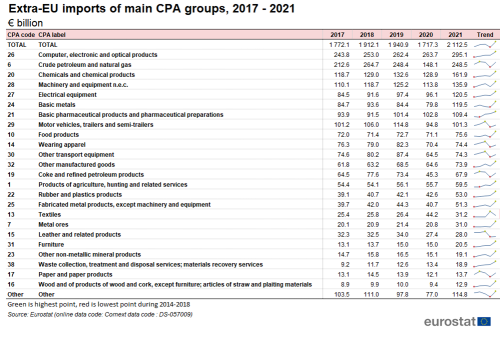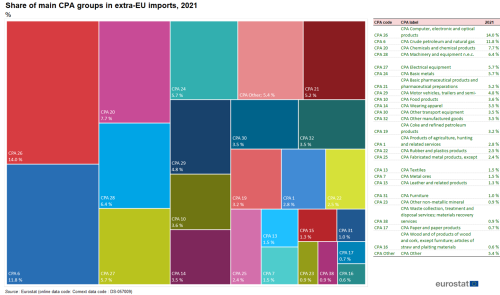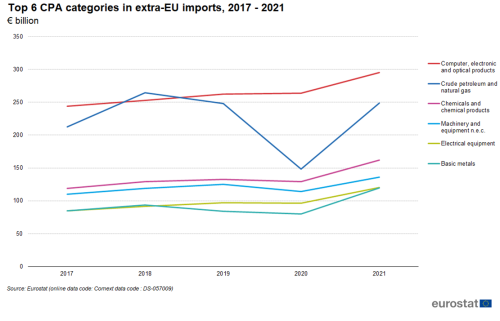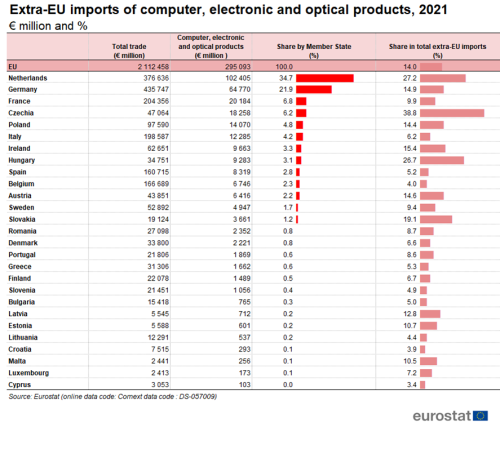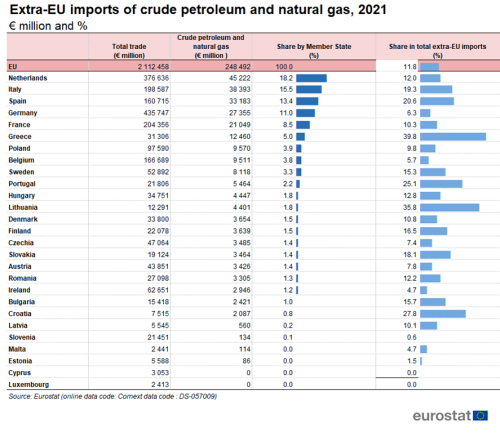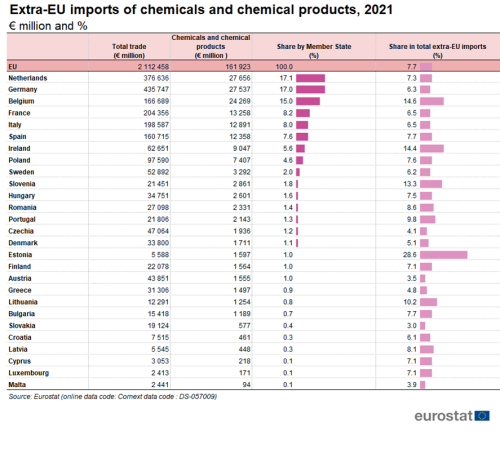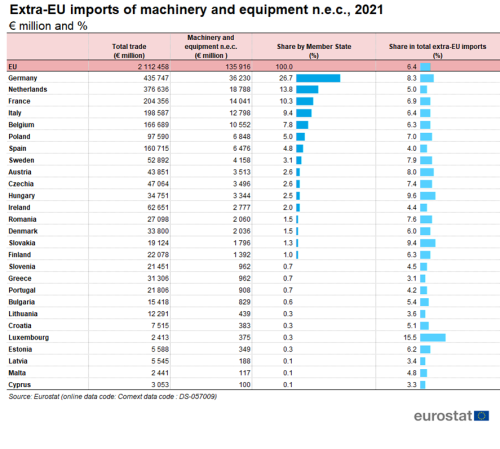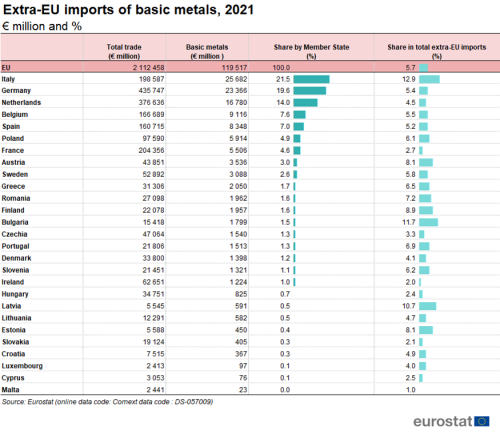Archive:Main goods in extra-EU imports
This Statistics Explained article has been archived - for recent articles on International trade in goods see here.
Data extracted in April 2021.
Planned article update: April 2023.
Highlights
Computer, electronic & optical products and crude petroleum & natural gas were the two most imported products by the EU every year between 2017 and 2021.
In 2021, the top 6 EU import products were computer, electronic & optical products (14 % of total imports), crude petroleum & natural gas (12 %), chemicals & chemical products (8 %), machinery & equipment, electrical equipment and basic metals (all three 6 %).
Top 6 CPA categories in extra-EU imports, 2017 - 2021
This article focuses on the most significant goods by value (according to the CPA classification) in extra-EU imports. It presents statistics for the EU from 2017 to 2021. Imported goods can be final goods but can also be important inputs for European industries. The article discusses the share of individual Member States in total extra-EU imports for the five most imported product groups. Additionally, it shows the share these product groups have in each Member State's total extra-EU imports of goods.
The article is part of an online publication providing recent statistics on international trade in goods, covering information on the EU's main partners, main products traded, specific characteristics of trade as well as background information.
Full article
EU imports by CPA groups
The CPA classification consists of 40 products. The 24 most imported products (with a value of more than €10 billion in 2021) are shown in Table 1, while the other 16 are grouped as "Other". Due to the Covid-19 pandemic, imports for 18 of the 24 most imported products decreased in 2020, however there was a notable increase of 68 % for textiles (CPA group 13) which includes face masks. In 2021, textiles was the only group where imports did not increase.
The composition of total EU imports of goods in 2021 for the 24 CPA groups in Table 1 is shown in Figure 1. The most imported products are, 'Computer, electronic and optical products' (computers) with 14.0 % and 'Crude petroleum and natural gas' (oil & gas) with 11.8 %. Following at a distance, the next four products are , 'Chemicals and chemical products' (chemicals) with 7.7 %, 'Machinery and equipment n.e.c' (machines) with 6.4 %, 'Electrical equipment' and 'Basic metals', both with 5.7 %. It is on these six product groups that the rest of the article will concentrate.
The 4 top product groups from 2021 were continuously in the top 4 from 2017 to 2021 (Figure 2). Throughout the whole period, the same product groups occupied the top two places, namely computers and oil & gas. They switched top position in 2018 and 2019 mainly due to changing prices for crude petroleum. Chemicals and machines were third and fourth throughout the period while pharmaceuticals dropped out of the top six in 2021, and was replaced by basic metals whose share was almost equal to that of electrical equipment.
Computer, electronic and optical products
In 2021, the Netherlands was the largest importer of computers in the EU (Table 2). Its imports of €102 billion were 34.7 % of total EU imports from countries outside the EU. The high value of the Netherlands is partly due to quasi-transit trade. Germany (€65 billion, 21.9 % of total EU imports) was the second largest importer. There were three Member States where the share of computers in their total imports from countries outside the EU was above 20 %. These were Czechia (38.8 %), the Netherlands (27.2 %) and Hungary (26.7 %).
Crude petroleum and natural gas
In 2021, the Netherlands was the largest importer of petroleum in the EU (Table 3). Its imports of €45 billion were 18.2 % of total EU imports from countries outside the EU. Italy (€38 billion, 15.5 % of total EU imports) was the second largest importer. There were five Member States where the share of petroleum in their total imports from countries outside the EU was above 20 %. These were Greece (39.8 %), Lithuania (35.8 %), Croatia (27.8 %), Portugal (25.1 %) and Spain (20.6 %).
Chemicals and chemical products
In 2021, the Netherlands was the largest importer of chemicals in the EU (Table 4). Its imports of €28 billion were 17.1 % of total EU imports from countries outside the EU. It was closely followed by Germany (€28 billion, 17.0 % of total EU imports). There were five Member States where the share of chemicals in their total imports from countries outside the EU was above 10 %. These were Estonia (28.6 %), Belgium (14.6 %), Ireland (14.4 %), Slovenia (13.3 %) and Lithuania (10.2 %).
Other machinery and equipment
In 2021, Germany was the largest importer of machines in the EU (Table 5). Its imports of €36 billion were 26.7 % of total EU imports from countries outside the EU. The Netherlands (€19 billion, 13.8 % of total EU imports) was the second largest importer. There was one Member State where the share of machines in their total imports from countries outside the EU was above 10 %. This was Luxembourg (15.5 %).
Electrical equipment
In 2021, Germany was the largest importer of electrical equipment in the EU (Table 6). Its imports of €34 billion were 27.8 % of total EU imports from countries outside the EU. The Netherlands (€15 billion, 12.7 % of total EU imports) was the second largest importer. There were three Member States where the share of electrical equipment in their total imports from countries outside the EU was above 10 %. These were Slovakia (11.7 %), Hungary (11.6 %) and Czechia (10.4 %).
Basic metals
In 2021, Italy was the largest importer of basic metals in the EU (Table 7). Its imports of €26 billion were 21.5 % of total EU imports from countries outside the EU. Germany (€23 billion, 19.6 % of total EU imports) was the second largest importer. There were three Member States where the share of basic metals in their total imports from countries outside the EU was above 10 %. These were Italy (12.9 %), Bulgaria (11.7 %) and Latvia (10.7 %).
Source data for tables and graphs
Data sources
EU data is taken from Eurostat's COMEXT database. COMEXT is the reference database for international trade in goods. It provides access not only to both recent and historical data from the EU Member States but also to statistics of a significant number of third countries. International trade aggregated and detailed statistics disseminated via the Eurostat website are compiled from COMEXT data according to a monthly process.
Data are collected by the competent national authorities of the Member States and compiled according to a harmonised methodology established by EU regulations before transmission to Eurostat. For extra-EU trade, the statistical information is mainly provided by the traders on the basis of customs declarations.
EU data are compiled according to Community guidelines and may, therefore, differ from national data published by the Member States. Statistics on extra-EU trade are calculated as the sum of trade of each of the 27 EU Member States with countries outside the EU. In other words, the EU is considered as a single trading entity and trade flows are measured into and out of the area, but not within it.
The United Kingdom is considered as an extra-EU partner country for the EU for the whole period covered by this article. However, the United Kingdom was still part of the internal market until the end of the transitory period (31 December 2020), meaning that data on trade with the United Kingdom are still based on statistical concepts applicable to trade between the EU Member States. Consequently, while imports from any other extra-EU trade partner are grouped by country of origin, the United Kingdom data reflect the country of consignment. In practice this means that the goods imported by the EU from the United Kingdom were physically transported from the United Kingdom but part of these goods could have been of other origin than the United Kingdom. For this reason, data on trade with the United Kingdom are not fully comparable with data on trade with other extra-EU trade partners.
Methodology
According to the EU concepts and definitions, extra-EU trade statistics (trade between EU Member States and non-EU countries) do not record exchanges involving goods in transit, placed in a customs warehouse or given temporary admission (for trade fairs, temporary exhibitions, tests, etc.). This is known as ‘special trade’. The partner is the country of final destination of the goods for imports and the country of origin for imports.
Dutch trade flows are over-estimated because of the so-called ‘Rotterdam effect’ (or quasi-transit trade): that is goods bound for other EU countries arrive in Dutch ports and, according to EU rules, are recorded as extra-EU imports by the Netherlands (the country where goods are released for free circulation). This in turn increases the intra-EU flows from the Netherlands to those Member States to which the goods are re-exported. To a lesser extent, Belgian figures are similarly overestimated.
Product classification
Classification of products by activity (CPA) is a statistical classification of products and services obligatory for all EU Member States. CPA classifies products by activity in which they are produced. Products are transportable goods and services. The CPA is a product classification whose elements are related to activities as defined by NACE Rev. 2. Each product - whether it be a transportable or a non-transportable good or a service - is assigned to one single NACE Rev. 2 activity. The linkage to activities as defined by NACE Rev. 2 gives the CPA a structure parallel to that of NACE Rev. 2 at all levels distinguished by NACE Rev. 2.
Unit of measure
Trade values are expressed in millions or billions (109) of euros. They correspond to the statistical value, i.e. to the amount which would be invoiced in the event of sale or purchase at the national border of the reporting country. It is called a FOB value (free on board) for imports and a CIF value (cost, insurance, freight) for imports.
Context
Trade is an important indicator of Europe’s prosperity and place in the world. The bloc is deeply integrated into global markets both for the products it sources and the imports it sells. The EU trade policy is an important element of the external dimension of the ‘Europe 2020 strategy for smart, sustainable and inclusive growth’ and is one of the main pillars of the EU’s relations with the rest of the world.
Because the 27 EU Member States share a single market and a single external border, they also have a single trade policy. EU Member States speak and negotiate collectively, both in the World Trade Organization, where the rules of international trade are agreed and enforced, and with individual trading partners. This common policy enables them to speak with one voice in trade negotiations, maximising their impact in such negotiations. This is even more important in a globalised world in which economies tend to cluster together in regional groups.
The openness of the EU’s trade regime has meant that the EU is the biggest player on the global trading scene and remains a good region to do business with. Thanks to the ease of modern transport and communications, it is now easier to produce, buy and sell goods around the world which gives European companies of every size the potential to trade outside Europe.
Direct access to
- International trade in goods - long-term indicators (t_ext_go_lti)
- International trade of machinery and transport equipment (SITC 7), by declaring country (tet00009)
- Extra-EU27 trade of machinery and transport equipment (SITC 7), by Member State (tet00059)
- Extra-EU27 trade of machinery and transport equipment (SITC 7), by main partners (tet00030)
- International trade in goods - short-term indicators (t_ext_go_sti)
- Imports of goods - machinery and transport equipment (teiet170)
- imports of goods - machinery and transport equipment (teiet070)
- International trade in goods - aggregated data (ext_go_agg)
- International trade in goods - detailed data (detail)
- International trade in goods statistics - background
- International trade in goods (ESMS metadata file — ext_go_esms)
- User guide on European statistics on international trade in goods
- Regulation (EC) No 471/2009 of 6 May 2009 on Community statistics relating to external trade with non-member countries
- Summaries of EU Legislation: Extrastat: statistics relating to trade with non-EU countries
- Regulation (EU) No 92/2010 of 2 February 2010 implementing Regulation (EC) No 471/2009, as regards data exchange between customs authorities and national statistical authorities, compilation of statistics and quality assessment
- Regulation (EU) No 113/2010 of 9 February 2010 implementing Regulation (EC) No 471/2009 , as regards trade coverage, definition of the data, compilation of statistics on trade by business characteristics and by invoicing currency, and specific goods or movements.
